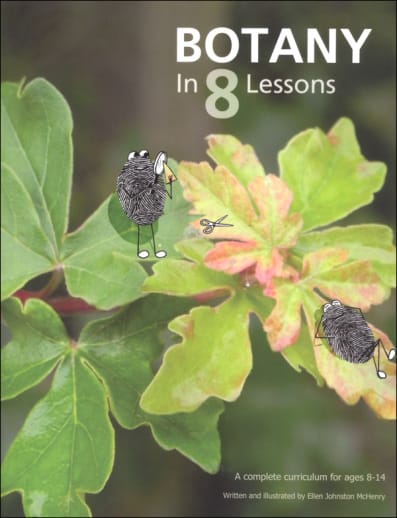Botany in 8 Lessons
Description
About the student text: The 100-page student text has 8 chapters, and each chapter is divided into two levels. All students complete level 1. Students who are younger or who have limited interest may want to stop after level 1. Level 2 provides additional information on the same topic for students who want to read more. You can choose to do some level 2s and skip others. At the end of each level there are review activities such as quiz questions, crossword puzzles, letter puzzles and Internet links that provide videos or online activities. The table of contents is included with the free download of the first two chapters.
Summary of contents: Chapter 1: Plant cell anatomy and photosynthesis, Chapter 2: Plant classification (vascular, non-vascular, seeds, seedless, angiosperms, gymnosperms, monocots, dicots), Kingdom/phylum/class/order/family/genus/species, where some plant names came from, Chapter 3: Non-vascular plants (mosses, liverworts, osmosis, alternation of generations), Chapter 4: Vascular structures (xylem, phloem), transpiration, monocots, dicots, plant hormones, tropisms), Chapter 5: Leaf anatomy, classification of leaf arrangements (pinnate, palmate, etc.), stomata, pigments, herbaceous and woody stems, leaf shapes, Chapter 6: Reproduction in ferns, reproduction in gymnosperms and angiosperms, pollination, germination, classification of fruits (dry fruits, succulents, etc.), legumes, types of seeds, spores, Chapter 7: Adaptations (desert, carnivorous, under water), poisonous and parasitic plants, Chapter 8: Diseases, brief intro to fungi, viruses, bacteria, famous diseases (tobacco mosaic, etc.), galls, plant nutrition, plant pests
About the activity section: The activity section has over 100 pages of supplemental games, crafts, and experiments. Games provided include two games about photosynthesis, Tree Leaf Bingo, Plant Cell Penny Pitch, "Where Sheep May Safely Graze" (a game about poisonous plants), "Plant Pile Up" (a general review game), a scavenger hunt, and directions for downloading two games about flower identification. Labs include flower dissection, dissecting xylem tubes out of celery, experimenting with growing roots, testing soil pH, testing the strength of germinating seeds, testing percentage germination of seed packets, looking at pollen grains, experimenting with ethylene gas and ripening fruit, and watching osmosis. Art/craft activities include drawing the cross section of a leaf, a streaming chloroplasts flip book, an ATP pop gun, vascular cross section cookies, pressing leaves, and making a work of art from a microscopic cross section photo. A final review/test is also included. (Also, at the very back of the book are some "consumable" color pages that can be removed and used.)
Lapbook: Also included at the end of the activity section are patterns for over a dozen lapbook items. Many of these include gimmicks such as lifting flaps, pull tabs or pop-ups. (A visual overview of the lapbook is posted on YouTube.com/TheBasementWorkshop, on the Botany playlist.)
Supplemental videos: A special channel for this curriculum has been set up on YouTube.com/TheBasementWorkshop. It contains videos that correlate with each chapter. Most videos have been embedded from other sources, but a few were created specially for this curriculum. All videos have been thoroughly previewed.
The newest course by Ellen McHenry, this one takes middle-school and early high-school students on an activity-filled adventure through botany. The 8 lessons include: plant cells and photosynthesis, plant classification, non-vascular plants, the vascular system, leaves and trees, plant reproduction, plant adaptation, and plant diseases. Like some of her other science programs, this course book is made up of two parts: a student text (about 100 pages) and a teacher activity book (also about 100 pages). Note that the student text is also available separately. This student text is formatted a bit differently than some of her others. Each chapter is divided into two parts. The first part presents the basic information on that topic, while the second part goes into greater detail for the more interested or advanced student. So all students will read the first part, and the second part would be optional, at your discretion. This volume is also a bit different in that there are full-color illustrations and photos which really liven the book up.
Each chapter closes with a group of student activities which may include pencil-and-paper type activities (like word puzzles or quizzes) or internet links to videos, images, or online activities. The author has set up a YouTube channel for this course, and has carefully selected quite a few short videos for each chapter. These add an interactive feel to the course, and some are really pretty neat.
The teacher activity section of the book includes answer keys to activities in the student book as well as a wealth of hands-on activities for each chapter. These activities include experiments, arts and crafts activities, games, and much more than your standard "plunk a piece of celery in colored water" fare. Just a small sampling of these would include: testing the strength of germinating seeds, drawing a cross-section of a leaf, dissecting a flower, playing two games about photosynthesis, going on a scavenger hunt, testing soil pH, experimenting with ethylene gas and ripening fruit, creating a streaming chloroplasts flip book, playing a game about poisonous plants, and much more. A final review test is also included in this section, covering content from all eight chapters. The format of Ellen McHenry's courses lends themselves very well to a co-op setting, but they would be incredibly enjoyable to do with a group of your own children as well. Younger children, or even high-schoolers will want to get in on some of these activities! - Jess
| Product Format: | Softcover Book |
|---|---|
| Grades: | 5-9 |
| Brand: | Ellen McHenry's Basement Workshop |
| ISBN: | 9780988780804 |
| Length in Inches: | 11 |
| Width in Inches: | 8.5 |
| Height in Inches: | 0.5 |
| Weight in Pounds: | 1.4 |

